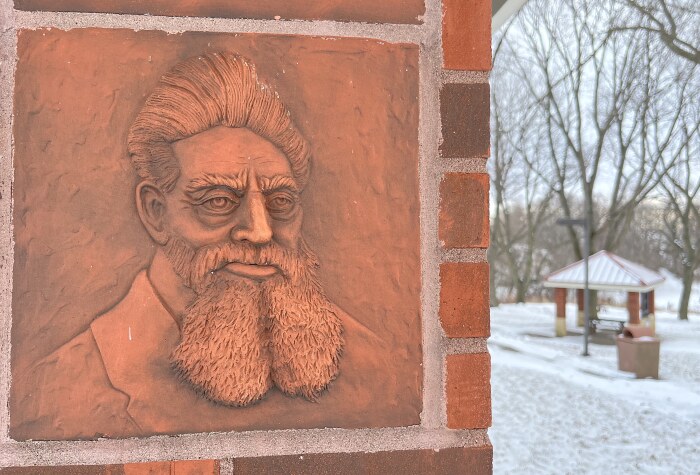This column by Daniel G. Clark about Alexander Clark (1826-1891) first appeared in the Muscatine Journal.
John Brown’s last trip across Iowa was in early 1859. He and his band left Muscatine County by rail in March. He would die at Charles Town, Virginia, in December.
In February 2009, a speaker at the dedication of the Alexander Clark conference room at Grimes State Office Building asked us to imagine a conversation between Clark and Brown.
“It’s possible they met because Clark gave safe harbor to escaping slaves and John Brown’s trail was only a half day ride from Clark’s home,” said Rudy Simms, director of the Des Moines Civil and Human Rights Commission.
It was a fun exercise, and I think Simms was right. They did know the some of the same people, and their activities ran parallel even if they did not connect or intertwine.
* * *
Because he owns Clark’s house, my friend Kent Sissel received a copy of Dr. Lowell Soike’s 2007 reply to a National Park Service survey about significant African American historical sites that could warrant consideration as National Historic Landmarks. The NHL designation is reserved for a select few properties nationwide.
Lowell had helped persuade Kent to restore the house decades before. Now he was nearing the end of a 36-year career as staff historian at the State Historical Society of Iowa. On behalf of the state, he recommended a single property for the NHL list: the Alexander Clark house.
He was also the driving force at the center of the Iowa Freedom Trail project. State Historical Society staff and volunteers were leveraging federal transportation dollars to try to discover and document whatever could still be learned about Iowa’s part in helping freedom-seekers escaping slavery.
Although Lowell’s NHL recommendation did not pull us into the Underground Railroad work at first, several of us who were telling Clark’s story saw a natural fit with the 1848 Jim White case I’ve told before. I’ve written about telling that story in the project’s 2007 conference. By 2009 I was deep into learning about “Bleeding Kansas” and its many Iowa angles and, of course, John Brown.
* * *
Last week I wrote about meeting Dr. Paul Finkelman at Harpers Ferry. Lowell had recommended him because Paul had successfully argued NHL status for Dred Scott’s lawyer’s house in St. Louis. Paul was a protégé of the renowned historian John Hope Franklin, and what we learned of his own prodigious output of books and articles and TV appearances impressed us.
Thus my last-minute decision to meet Paul at the “John Brown Remembered” symposium on the 150th anniversary of the Harpers Ferry raid.
On short notice I was able to crash at the home of college friend John C. Yoder. who was serving as a judge in eastern West Virginia.
He showed me a picture of himself in his robe sitting on the bench in the courtroom where John Brown was tried and convicted.
No longer in use as a courtroom, it was “assigned to me due to renovations in the regular courtroom,” he said.
In his newspaper column he told of the versions of the story he learned growing up in Kansas and going to school in Iowa.
“When I moved to Harpers Ferry 25 years ago, however, I began to hear other sides of the story about John Brown,” he wrote. “Those other perspectives included a belief that his violence and fanaticism may have actually hindered and embarrassed, rather than helped, those who favored the abolition of slavery at the time.”
He said he supported a proposal to restore the original courtroom where Brown was tried. It could preserve a heritage “and hopefully bring even more tourism to the area.”
* * *
I wonder how many area residents have ever visited Iowa’s Underground Railroad attraction at Mile Post 270 on eastbound Interstate 80. Have you?
Appearing in view, off to the right, it used to be my signal to slow down for the Highway 38 off-ramp. It meant I was almost home—time to slow to 55 and stay alert for the two-lane stretch into Muscatine.
What I learned when I eventually paid attention was that we locals were overlooking a gem of a teaching tool, the nearest of several “Art in Transit” rest stops designed by Des Moines artist David Dahlquist. December 22 was the 20th anniversary of its completion.
Go see it, if you haven’t, and make a point of finding the picnic shelter featuring full-bearded John Brown rendered in terracotta. His face is one of many images and elements making the place much more than a pit stop. Notice “Tabor” (Iowa author Marilynne Robinson’s fictional Gilead) at the western fence and “Fort Sumter” at the east—like bookends of an Iowa antislavery story.
On a poster showing nineteen “new generation” themed rest stops, the Iowa Department of Transportation says: “Iowa is incorporating art…to educate travelers on the cultural, historical, social, or natural resources of the area.”
Top image: Abolitionist John Brown is pictured on a picnic shelter at the I-80 rest area near the Wilton-Muscatine exit.

